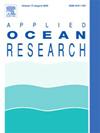Topology optimization on a jacket structure for offshore wind turbines by altering structural design domain
IF 4.3
2区 工程技术
Q1 ENGINEERING, OCEAN
引用次数: 0
Abstract
Topology optimization (TO) has been proven as a potent tool for offshore wind turbine supporting structure design. Typical TO methods optimize the material layout within a specific and fixed design domain that has previously been established. An investigation on the topology optimization design of jacket structure is conducted by altering the design domain, which is expanded by adopting two strategies of extending upwards and enlarging the distance between the legs at the bottom. The weighted and normalized compliance in two typical loading cases is adopted as the objective function subject to available material usage. The checkerboards are suppressed by minimum size constraints in the commercial software Optistruct ™, and geometrical symmetry is imposed to assure an identical material layout on four surfaces. Two sequences of innovative designs are automatically generated by the proposed strategies including expanding the leg distance and extending upwards to replace portions of the tower. To verify these optimized results, the jacket structures are reconstructed based on the initial structures and force transmission paths. Various structural responses such as the fundamental frequency of the entire offshore wind turbine, maximum displacement, and pull-out forces are investigated and analyzed to demonstrate the superiority of the presented approach in comparison to the reference structure. The effects of various parameters including water depth, wave height and system damping of a particular optimized structure are discussed. The resultant trends provide several suggestions for the jacket design.
求助全文
约1分钟内获得全文
求助全文
来源期刊

Applied Ocean Research
地学-工程:大洋
CiteScore
8.70
自引率
7.00%
发文量
316
审稿时长
59 days
期刊介绍:
The aim of Applied Ocean Research is to encourage the submission of papers that advance the state of knowledge in a range of topics relevant to ocean engineering.
 求助内容:
求助内容: 应助结果提醒方式:
应助结果提醒方式:


